Chelsea Hospital for Women
Dovehouse Street, Chelsea, SW3 6LT
Medical dates:
Medical character:
1871- 1988
Specialist
The Chelsea Hospital for Women was established by Drs Thomas Chambers (1829-1896) and James Hobson Aveling (1828-1892) in 1871 in a house at 178 King's Road. It had 8 beds.
It catered for the medical needs of distressed gentlewomen and the deserving poor, but the Hospital quickly was found to be too small. Applications for admission had increased five-fold, but there was no possibility of expansion. A larger site on the south side of Fulham Road beside the Jewish cemetery was purchased and building work began in 1880, with the Princess of Wales laying the foundation stone.
The Hospital was officially opened in 1883 by the Duchess of Albany. It had 63 beds and was the first to be built specifically dedicated to gynaecological disorders.
In 1889 the Duchess of Albany returned to open the new Nurses' Home in Neville Street, with accommodation for 12 probationers, and also visited the Hospital. At this time the only parts of the Hospital lit by electrical light were the operating theatre, the Out-Patients Department and the consulting rooms. An Appeal was launched to finance improvements to the lighting system in the rest of the building, estimated as up to £2,000. The Hospital was closed while the work was undertaken, and it reopened in October. A new electric lift had been installed, as well as a new hot water system, and the operating theatre enlarged. The work had cost £3,000, of which half had been subscribed.
In 1891 a purpose-built convalescent home opened at St Leonard's-on-Sea.
By the turn of the century the Hospital premises had become inadequate and in 1911 Earl Cadogan donated a piece of land (worth £22,000) in Arthur (later renamed Dovehouse) Street on which to build a larger hospital.
The new Hospital was officially opened by Queen Mary on 11th July 1916. The wards were small but homely and attractive in appearance. By January 1917 some 57 of the 95 beds were in use by patients, while the staff occupied the remainder until a Nurses' Home could be built. By 1921 the sum of £16,000 had been collected for this purpose, but there was still a shortfall of £13,000.
The Nurses' Home was finally completed in 1924.
In 1933 the wards were extended, and further additions to the Hospital
and Nurses' Home were made during 1938-39. A new heating system was
installed. Queen Mary opened a new £34,000 extension to the
Hospital in May 1939. The Hospital then had 126 beds, including a
wing with 6 single rooms.
In 1939 Arthur Street was renamed Dovehouse Street.
At the beginning of WW2 in 1939 the Hospital joined the Emergency Medical Service.
In 1940 it was designated a '1A' hospital, with 60 beds placed at
the disposal of the Ministry of Health for civilian casualties.
The danger from air raids resulted in evacuation of the top
floor, with a resultant reduction in the number of beds. In April
1941 the building suffered some bomb damage. During the war some
of the Hospital's patients were treated at the South Middlesex Hospital in Isleworth.
After WW2 the Hospital opened a fertility clinic, treating women from
all over London and the country.
It joined the NHS in 1948 and became a Teaching Hospital, sharing the same Board of Governors as Queen Charlotte's Hospital in Hammersmith.
In 1953 two research wings were opened.
By 1976 the Hospital had 86 beds.
In 1988 it closed and all services were transferred to Queen Charlotte's Hospital.
|
Present status (April 2008) |
|---|
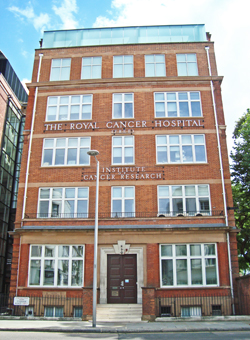
The original Hospital building at 237 Fulham Road, which became the Freemasons' Hospital and Nursing Home. Today it is the Chester Beatty Laboratories, part of the Institute of Cancer Research.
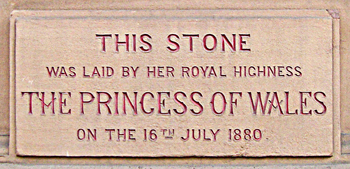
The foundation stone laid by the Princess of Wales in 1880.
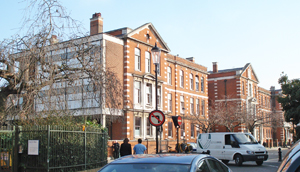
The main block in Dovehouse Street, which opened in 1916, as seen from the north.

The main block as seen from the south.
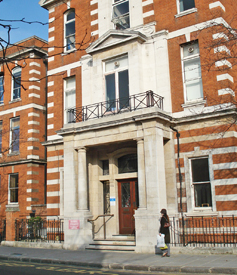
The main entrance.

The name of the Hospital is engraved above the door.

The south block - the former Nurses' Home - is now the
Britten Street Wing of the Royal Brompton Hospital.
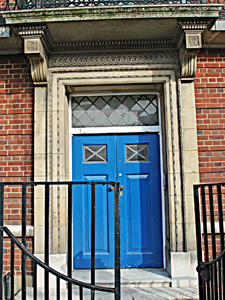
The entrance to the south block in Dovehouse Street.
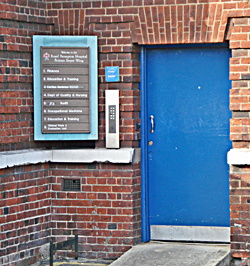
Entrance to the south block in Britten Street.
References (Accessed 3rd January 2017)
(Author unstated) 1889 Chelsea Hospital for Women. Nursing Record and Hospital World, 28th January, 77-78.
(Author unstated) 1889 Reflections from a Board Room mirror. Nursing Record and Hospital World, 14th October, 318.
(Author unstated) 1912 The Chelsea Hospital for Women. British Journal of Nursing, 13th January, 32
(Author unstated) 1917 Chelsea Hospital for Women. British Journal of Nursing, 13th January, 32.
(Author unstated) 1925 The Chelsea Hospital for Women. The Nurses' Home. British Journal of Nursing (June), 127.
Iveson-Iveson J 1985 Hospital histories, 10. Chelsea Hospital for Women. Nursing Mirror 160 (20), 18.